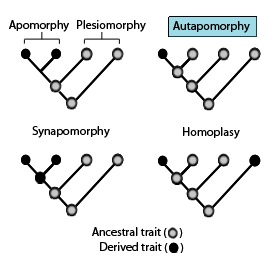
Back تواسم مشتق ذاتي Arabic Autapomorfia Catalan Autapomorphie German Mempomorfo Esperanto Autoapomorfia Spanish خودجداریختی Persian Autapomorphie French Apomorfia és pleziomorfia Hungarian Autapomorfi ID Autapomorfia Italian

In phylogenetics, an autapomorphy is a distinctive feature, known as a derived trait, that is unique to a given taxon. That is, it is found only in one taxon, but not found in any others or outgroup taxa, not even those most closely related to the focal taxon (which may be a species, family or in general any clade).[2] It can therefore be considered as an apomorphy in relation to a single taxon.[3] The word autapomorphy, introduced in 1950 by German entomologist Willi Hennig, is derived from the Greek words αὐτός, autos "self"; ἀπό, apo "away from"; and μορφή, morphḗ = "shape".[4]
- ^ Page RD, Holmes EC (14 July 2009). Molecular Evolution: A Phylogenetic Approach. John Wiley & Sons. ISBN 978-1-4443-1336-9. OCLC 609843839.
- ^ Futuyma DJ (1998). Evolutionary Biology (3rd ed.). Sinauer Associates, Inc. p. 95.
- ^ Appel RD, Feytmans E (2009). "Chapter 3: Introduction of Phylogenetics and its Molecular Aspects". Bioinformatics: a Swiss Perspective (1st ed.). World Scientific Publishing Company.
- ^ Calow PP (2009). Encyclopedia of Ecology and Environmental Management. John Wiley & Sons. ISBN 978-1-4443-1324-6. OCLC 1039167559.